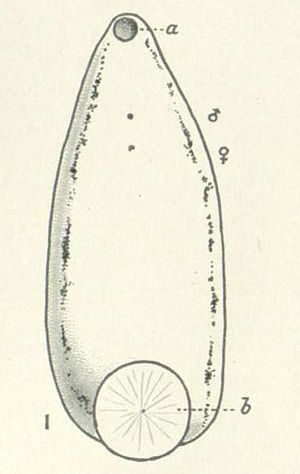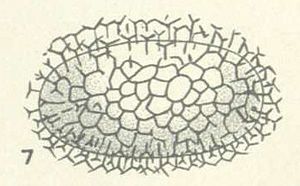Hirudobdella antipodum facts for kids
Quick facts for kids Hirudobdella antipodum |
|
|---|---|
 |
|
| Scientific classification | |
| Kingdom: | |
| Phylum: | |
| Class: |
Clitellata
|
| Subclass: | |
| Order: |
Arhynchobdellida
|
| Family: |
Hirudinidae
|
| Genus: |
Hirudobdella
|
| Species: |
H. antipodum
|
| Binomial name | |
| Hirudobdella antipodum (Benham, 1904)
|
|
The Hirudobdella antipodum is a special kind of leech that lives only on the Open Bay Islands in New Zealand. Unlike many leeches, this one lives on land. It likes to feed on the feet of seabirds that are nesting. Sadly, there are not many of these leeches left. Most of them now live under just one large rock! Their numbers dropped a lot because of a bird called the weka, which was brought to the islands.
Contents
How This Leech Was Found
The First Discovery
This unique leech was first found in February 1903. A botanist named Leonard Cockayne and a chemist named Walter Dunlop were visiting Taumaka. This is the biggest island in the Open Bay group. Mr. Dunlop was looking for wētā (a type of insect) in burrows where seabirds called muttonbirds lived.
Suddenly, he was bitten on his wrist! Luckily, Mr. Dunlop was very interested in nature. He carefully pulled his hand back and saw a leech attached to it. This is how the Hirudobdella antipodum was first discovered.
Rediscovery After Many Years
Later, a bird called the weka (Gallirallus australis) was brought to the Open Bay Islands. By 1969, people thought the weka had eaten all the leeches, and they were extinct. But in 1987, the leeches were found again! They were living in wet burrows made by penguins. These burrows were under a very large rock, about 5 meters by 2 meters in size.
For the next ten years, scientists checked this rock often. They confirmed that the leeches were still alive and having babies there. At that time, this one spot was the only place in the world where these leeches were known to live.
Leech Life and Habits
Where They Live
Land leeches need places that are wet or damp. This helps keep their skin moist. It also helps them get rid of waste. So, you usually find them in forests. On the Open Bay Islands, the H. antipodum leeches were found in wet burrows or in piles of wet sticks.
What They Eat
Most land leeches eat blood from mammals. But the leeches in New Zealand have learned to feed on birds. The Open Bay Islands leech mainly feeds on the feet of seabirds that are nesting. They especially like Fiordland penguins (Eudyptes pachyrhynchus).
Leeches can drink a lot of blood, much more than their own body weight. It can take them months to digest just one meal! When it's not nesting season for birds, H. antipodum might eat other animals. This could include fur seals or even earthworms. Long ago, New Zealand land leeches might have even fed on active forest birds, like the giant moa, which is now extinct.
Reproduction
Leeches are hermaphrodites. This means they have both male and female parts. Leeches like the H. antipodum lay 5 to 10 eggs inside special cases called cocoons. When the leech was first found, scientists also found two empty cocoons. These cocoons were oval-shaped, about 14 millimeters long, and dark brown with a tough feel.
Protecting the Leech
Why They Are in Danger
The biggest reason why these leeches are disappearing is probably because of the weka bird (Gallirallus australis). The Open Bay Islands do not have mammal predators like rats or mice. Weka birds were brought to the islands in the 1900s. They eat nesting seabirds, their eggs, and other animals like the Open Bay Islands gecko and the Open Bay Islands skink. Since H. antipodum is active during the day and moves across open ground, weka can easily catch them.
What Can Be Done
The Department of Conservation has suggested removing the weka birds from the islands. However, the owners of the islands, the Māori tribe Poutini Ngai Tahu, do not agree. They were partly responsible for bringing the weka to the islands.
Another idea is to keep some leeches in a special protected area. This would be like a "backup" population. That way, if the leeches disappear from the island, they would still exist somewhere else.
It can be hard to get people excited about protecting a leech. Some people might not think a leech is as important as a bird or a seal. But every creature plays a part in its ecosystem.


